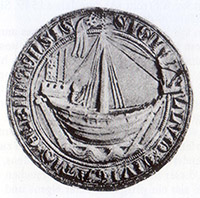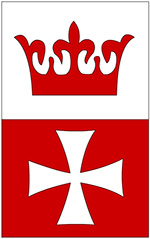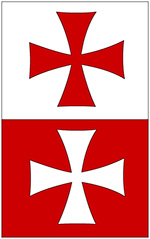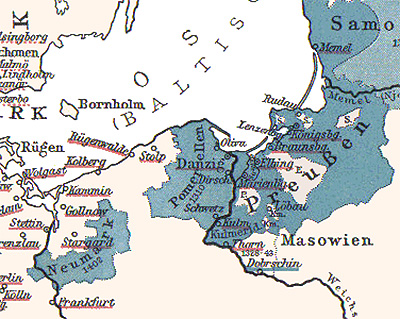Hanseatic post in East Prussia

The need to exchange news and deliver letters arose quite early in business circles. Some merchants kept their own messengers or hired them to send their correspondence. Merchant guilds had their own permanent staff postal couriers. Sometimes pilgrims, travelers, itinerant craftsmen and even professional beggars were used as "letter bearers". Some cities also had their own postal service (Hamburg in 1258 and Lübeck in 1259 were among the first to acquire such a service). During its heyday (late 14th - late 15th centuries), the largest trade union in Europe, the Hanseatic League, also had its own postal service.
The trade relations of the North German merchants, primarily those of Lübeck, with the southern Baltic coast date back to pre-Order times. With the arrival of the German Order in Prussia, these relations only strengthened. Several settlements founded by the Order on the conquered Prussian lands received city rights in accordance with Lübeck law (Elbing/Elbląg, Braunsberg/Braniewo). In general, during the existence of the Hanse, several cities of the German Order were its members. In addition to the already mentioned Elbing and Braunsberg, the Hanseatic League also included Kulm/Chelmno, Thorn/Torun, Königsberg (or rather all three cities that were part of it: Altstadt, Löbenicht and Kneiphof), as well as Memel/Klaipeda and Danzig/Gdansk.


The Hanseatic merchants carried out postal services on their cogged ships. But already in 1360 the Hansa opened a horse postal route connecting Bruges, where the union's head office had been located since 1252, and Riga. Its length was approximately 2000 km, and the main intermediate points were the cities of Antwerp, Cologne, Bremen, Hamburg, Lübeck, Greifswald, Stettin/Szczecin, Kolberg/Kolobrzeg, Stolp/Slupsk, Oliva, Danzig, Elbing, Königsberg, Libau/Liepaja.
Despite the presence of mounted messengers, until the early 15th century most correspondence sent overland was carried by foot couriers. Horsemen ( rydenboden ) carried only the most urgent mail.
The land method of delivery, although slower than sea, was considered more reliable. In cases of special importance or urgency, letters were sent both by sea and by land. For example, a letter sent on July 14, 1438 from Danzig by sea arrived at the Hanseatic office in Antwerp on July 31, and a copy of the same letter was delivered by a messenger only on August 23, i.e. three weeks later.
It should also be noted that the delivery of mail until the mid-15th century was not regular (the messenger would set off only after a sufficient amount of correspondence had been collected), and since the work of postmen was not coordinated, they often had to wait for their colleagues at intermediate points to exchange correspondence. In Prussia, such intermediate points on the Bruges-Riga route were Danzig (there the correspondence exchange point was located in the Königsberger Keller (Königsberg basement) on Langer Markt (now Dlugi Targ square) and Königsberg. This route had a branch connecting Danzig with Kulm and Thorn.
In 1449, the Danzig magistrate hired Matthias Merkel as a messenger, who was charged with delivering letters sent by the magistrate, Hanseatic merchants and citizens. To give the messenger a special status, he was given a special mail bag, distinguishing him from others.
In the first half of the 15th century, in some Hanseatic cities there were both postmen engaged in inter-city delivery ( loper ) and city messengers ( stadebote ).
In the same Danzig, a certain Hans Kruse, who served as a messenger for the German Order in 1419-1428 and carried correspondence between Prussia and the Roman Curia, in 1429 entered the service of a messenger (moreover, both as a city and intercity postman - loper und bote ) in the Danzig magistrate and began delivering letters between the Netherlands, Bremen, Lübeck and Danzig, as well as between Danzig and Thorn, and worked in this position until at least 1442.
He was only one of five such Danzig couriers. Among them was a certain Hermann Osterrode, who served as a courier in 1427-1449 and carried correspondence between Flanders, Lübeck and Livonia. He was also a messenger for the Hanseatic headquarters in Bruges. At that time, such a combination of duties by messengers was not uncommon. The already mentioned Matthias Merkel also became a messenger for the Hanseatic office in Lübeck in 1449.
In addition to correspondence, Hanseatic postmen also conveyed oral messages from senders that they did not risk entrusting to paper, transported money (not only from merchants, but also from ordinary citizens), and even expensive fabrics and spices, and also performed various diplomatic functions, acting in negotiations on behalf of their clients.
In 1580, the Hanseatic League issued the so-called Botenordnung – rules and liability measures for postal couriers – the first known of its kind.
The Hanseatic post existed simultaneously with the Order post. At the same time, a certain "division of labor" was observed between these services. The Order post delivered mainly official state correspondence, and the merchant post dealt with commercial and private correspondence. At the same time, the Order post operated, for the most part, only on the territory of the Order state.

At the end of the 19th century, a private postal service called “Hansa” (Privat-Post “Hansa”) existed for a short time in Germany, with branches in many large cities, including Königsberg.
Sources:
Benkmann H.-G. Königsberg (Pr.) and its Post. An article about the post in Königsberg (Pr.) from the order until 1945. Schild-Verlag, Munich, 1981.
Brandtner G., Vogelsang E. The Post in East Germany. They were told to leave the house on the 20th of July. — Verlag Nordostdeutsches Kulturwerk, Lüneburg, 2000.
Czaja R. Collection of lists of ancient Hanseatic cities in the military history of the 14th-15th centuries. — „Klio. “Czasopismo poświęcone ziejm Polski i powszechnym”, 2012, vol. 23, s. 8-9.
